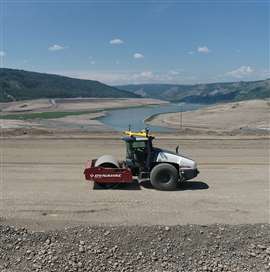Trimble completes first test of a fully autonomous soil compactor on live jobsite
09 November 2023
Trimble has completed its first test of a fully autonomous soil compactor on a live job site.
 This is said to be one of the industry’s first public tests of a fully autonomous compactor on a live construction site (Photo: Trimble)
This is said to be one of the industry’s first public tests of a fully autonomous compactor on a live construction site (Photo: Trimble)
The Trimble Earthworks Grade Control Platform for Autonomous Compactors was tested on a Dynapac CA 5000 soil compactor on the Site C Clean Energy Project on the Peace River in northeast British Columbia, Canada.
This is said to be one of the industry’s first public tests of a fully autonomous compactor on a live construction site.
Trimble says that the fully autonomous machine completed 37 hours of real compaction work, operating alongside a mixed fleet of compactors, the rest of which were running the Trimble CCS900 Compaction Control System.
Data from all machines – both with and without an operator – were delivered using Trimble WorksOS Software, which is being used as the system of record for all compaction data on the job site.
“The Site C project was the perfect place to begin live testing of the fully autonomous soil compactor because of the cost and safety benefits autonomy will bring to large infrastructure projects like this in the future,” said Cameron Clark, earthmoving industry director for Trimble’s civil infrastructure solutions.
“We are pleased that this initial testing reinforces our philosophy that autonomous technology will play an important role in delivering a cheaper, faster, safer and greener future for the construction industry.”
Trimble says that they will continue to perform extensive assisted testing through the rest of 2023 and into 2024 before making Trimble Earthworks for Autonomous Compaction available to select users for beta testing.
In other news, at Trimble Dimensions in Las Vegas, Trimble announced its next generation GNSS receiver — the Trimble MPS566 Modular GNSS heading receiver — designed for marine construction, drilling, and piling operations.
With built-in dual GNSS antenna ports and constellation-agnostic Trimble ProPoint technology, the MPS566 is able to deliver accurate positions and orientation for work that demands precise heading. With a rugged and compact form factor, the MPS566 consumes low power and has minimal cabling. Trimble says that these are all benefits when installation space is at a premium.
STAY CONNECTED



Receive the information you need when you need it through our world-leading magazines, newsletters and daily briefings.
CONNECT WITH THE TEAM












